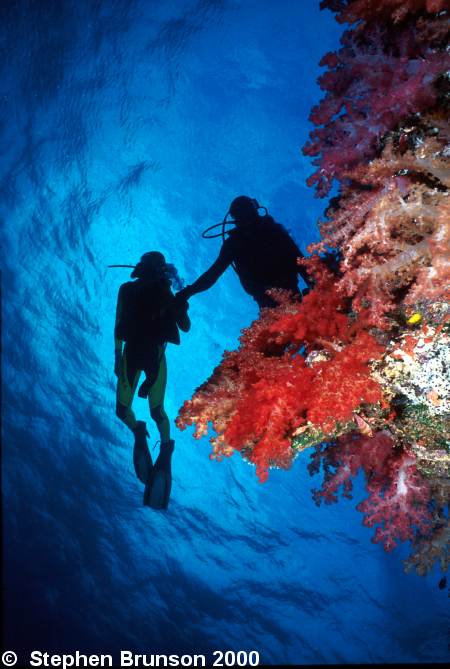








Scuba Divers and Coral Reefs
This photo was taken in Fiji, in the South Pacific. A picture type I refer to as "Honeymooners" because the scuba divers are holding hands. Notice the colorful soft coral reefs in the picture, common throughout the Islands of Fiji. I photographed all of these scuba divers and coral reefs with a super wide angle lens, the 15mm lens for the Nikonos V, and a 20mm lens for the Nikon 8010 with the Tussey Housing.

Print Number - SDS010
Limited Edition signed color photography for sale by Stephen Brunson
SCUBA History:
Self Contained Underwater Breathing Apparatus, or SCUBA, independent of diving suits has been
developed for skin diving. It differs from the conventional diving suit in that it is designed
for swimming, whereas the more cumbersome type is suitable only for walking on ocean floors.
One form of this apparatus, a lightweight breathing mask operating on the same principle as the
self-contained diving suit, was used during World War II by underwater demolition teams to
clear away mines and other obstacles before amphibious landings. At present, the most popular
form is the aqualung designed in France during World War II by the French naval officer and
underwater explorer Jacques Yves Cousteau. It consists of one, two, or three cylinders,
carried on the divers back, of compressed air fed to the divers mouthpiece though valves
that assure a constant flow at a pressure automatically equalized with outside water pressure.
Today's divers usually plan their dive and then dive their plan to make scuba diving more
enjoyable and safe for all the divers. Buddy diving is very important for the safety and
enjoyment of scuba diving. For instance, if there is an equipment malfunction with the divers
regulator, the buddy diver can assist in the emergency by providing his buddy with air,
instead of making an emergency ascent.
Coral Reefs:
Coral reefs are complete ecosystems with well-defined structures that involve both
photosynthetic plants and consumers. The outer layer of a reef consists of living polyps of
coral. Within the coral animals live single-celled, round, yellow algae called zooxanthellae.
Below and surrounding the polyps is a calcareous skeleton, both lving and dead, that contains
filament green algae. Other species of algae, both fleshy and calcareous, grow in the
surface of old skeletal deposits. These algae and other associated plants make up most of
the primary producers.
The photosynthetic zooxanthellae and the filamentous green algae apparently transfer some
food energy directly to the coral polyps. Coral animals, in turn, feed at night on
zooplankton, which they capture with their tentacles. Coral animals prey on zooplankton
not so much for the calories but for the scarce nutrients, especially phosphorous. Through
digestion, coral animals release these nutrients to the algae. Coral and algae then seem to
cycle these nutrients between them, reducing the nutrient loss to the water.
Herbivorous fish, such as the colorful butterfly fish, as well as sea urchins, sea cucumbers,
brittle stars, and numerous species of mollusks, feed on algae. Hiding in the numerous caves
and crevices of a reef are predatory animals, cush as small crabs, wrasses, moray eels, and
sharks. The numerous microhabitats and the productivity of the reefs support a great
diversity of fishes.
BrunsonImages@att.net


















